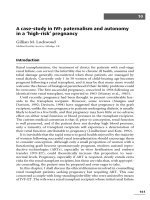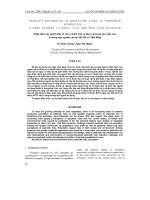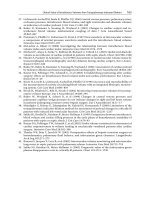Ebook Case studies in disaster response and emergency management: Part 1
Bạn đang xem bản rút gọn của tài liệu. Xem và tải ngay bản đầy đủ của tài liệu tại đây (1.32 MB, 127 trang )
American Society for Public Administration
Series in Public Administration and Public Policy
CASE STUDIES IN
DISASTER RESPONSE
AND EMERGENCY
MANAGEMENT
Nicolas A. Valcik and Paul E. Tracy
CASE STUDIES IN
DISASTER RESPONSE
AND EMERGENCY
MANAGEMENT
American Society for Public Administration
American Society for Public Administration
Book Series on Public Administration & Public Policy
David H. Rosenbloom, Ph.D.
Editor-in-Chief
Mission: Throughout its history, ASPA has sought to be true to its founding principles
of promoting scholarship and professionalism within the public service. The ASPA
Book Series on Public Administration and Public Policy publishes books that increase
national and international interest for public administration and which discuss practical or
cutting edge topics in engaging ways of interest to practitioners, policy makers, and
those concerned with bringing scholarship to the practice of public administration.
Recent PuBlicAtionS
case Studies in Disaster Response and emergency Management
Nicolas A. Valcik and Paul E. Tracy
Debating Public Administration:
Management challenges, choices, and opportunities
by Robert F. Durant and Jennifer R.S. Durant
Effective Non-Profit Management:
context, concepts, and competencies
by Shamima Ahmed
environmental Decision-Making in context: A toolbox
by Chad J. McGuire
Government Performance and Results: An evaluation of
GPRA’s First Decade
by Jerry Ellig, Maurice McTigue, and Henry Wray
Practical Human Resources for Public Managers:
A case Study Approach
by Nicolas A. Valcik and Teodoro J. Benavides
American Society for Public Administration
Series in Public Administration and Public Policy
CASE STUDIES IN
DISASTER RESPONSE
AND EMERGENCY
MANAGEMENT
Nicolas A. Valcik and Paul E. Tracy
CRC Press
Taylor & Francis Group
6000 Broken Sound Parkway NW, Suite 300
Boca Raton, FL 33487-2742
© 2013 by © 2013 by Taylor & Francis Group, LLC
CRC Press is an imprint of Taylor & Francis Group, an Informa business
No claim to original U.S. Government works
Version Date: 20130109
International Standard Book Number-13: 978-1-4398-8317-4 (eBook - PDF)
This book contains information obtained from authentic and highly regarded sources. Reasonable
efforts have been made to publish reliable data and information, but the author and publisher cannot
assume responsibility for the validity of all materials or the consequences of their use. The authors and
publishers have attempted to trace the copyright holders of all material reproduced in this publication
and apologize to copyright holders if permission to publish in this form has not been obtained. If any
copyright material has not been acknowledged please write and let us know so we may rectify in any
future reprint.
Except as permitted under U.S. Copyright Law, no part of this book may be reprinted, reproduced,
transmitted, or utilized in any form by any electronic, mechanical, or other means, now known or
hereafter invented, including photocopying, microfilming, and recording, or in any information storage or retrieval system, without written permission from the publishers.
For permission to photocopy or use material electronically from this work, please access www.copyright.com ( or contact the Copyright Clearance Center, Inc. (CCC), 222
Rosewood Drive, Danvers, MA 01923, 978-750-8400. CCC is a not-for-profit organization that provides licenses and registration for a variety of users. For organizations that have been granted a photocopy license by the CCC, a separate system of payment has been arranged.
Trademark Notice: Product or corporate names may be trademarks or registered trademarks, and are
used only for identification and explanation without intent to infringe.
Visit the Taylor & Francis Web site at
and the CRC Press Web site at
The authors dedicate this book to first responders everywhere. These individuals
risk their safety on a daily basis to come to the aid of victims from all kinds
of danger and emergency situations. Their efforts are noble, dedicated,
and unselfish, and we gratefully acknowledge their professionalism.
Contents
Foreword....................................................................................................... xix
ALLEN BARNES
Foreword....................................................................................................... xxi
TED BENAVIDES
Preface......................................................................................................... xxiii
Acknowledgments........................................................................................ xxv
About the Authors...................................................................................... xxvii
1 Guidelines and General Information for Public Officials and
Administrators........................................................................................1
Key Issues to Consider in Emergency or Disaster Response Situations.........1
Case Study Selection and the History of Disaster Response.................1
Basic Framework and Resources Needed for Disaster Response...........2
Basic Framework.................................................................................3
Plan of Action.............................................................................3
Communication Plan.................................................................5
Emergency Response Plan..........................................................6
Resources.............................................................................................6
Manpower..................................................................................6
Food and Water..........................................................................7
Medical Supplies and Resources.................................................8
Law Enforcement.......................................................................9
Specialized Equipment and Support...........................................9
Electricity and Fuel...................................................................10
Transportation..........................................................................11
Mortuary Services....................................................................11
Resources for Displaced Persons...............................................12
Emergency Facilities.................................................................12
Financial Resources..................................................................13
Communications......................................................................14
Intangible Factors That Affect Disaster Response.......................................14
vii
viii ◾ Contents
Coordination with Other Entities......................................................14
Authority...........................................................................................15
Scope of Operation............................................................................16
Political Disposition...........................................................................16
Time..................................................................................................17
Threat Level/Threat Assessment.........................................................17
Section I NATURAL DISASTERS
2 Case Studies: Disasters from Natural Forces—Fires.............................21
Richmond Theater Fire, Virginia, 1811.......................................................21
Stage 1 of the Disaster.......................................................................21
Stage 2 of the Disaster.......................................................................22
Stage 3 of the Disaster.......................................................................22
Stage 4 of the Disaster.......................................................................23
Stage 5 of the Disaster.......................................................................24
Stage 6 of the Disaster.......................................................................24
Key Issues Raised from the Case Study..............................................25
Items of Note.....................................................................................25
Great Chicago Fire, 1871............................................................................25
Stage 1 of the Disaster.......................................................................25
Stage 2 of the Disaster.......................................................................26
Stage 3 of the Disaster.......................................................................27
Stage 4 of the Disaster.......................................................................27
Stage 5 of the Disaster.......................................................................28
Stage 6 of the Disaster.......................................................................28
Stage 7 of the Disaster.......................................................................29
Key Issues Raised from the Case Study..............................................29
Items of Note.....................................................................................30
Peshtigo Fire, Wisconsin, 1871...................................................................30
Stage 1 of the Disaster.......................................................................30
Stage 2 of the Disaster.......................................................................31
Stage 3 of the Disaster.......................................................................31
Stage 4 of the Disaster.......................................................................32
Key Issues Raised from the Case Study..............................................33
Items of Note.....................................................................................33
Big Blowup, Washington, Idaho, and Montana, 1910.................................33
Stage 1 of the Disaster.......................................................................33
Stage 2 of the Disaster...................................................................... 34
Stage 3 of the Disaster...................................................................... 34
Key Issues Raised by the Case Study.................................................35
Items of Note.....................................................................................35
Contents ◾ ix
Hartford Circus Fire, Connecticut, 1944....................................................35
Stage 1 of the Disaster.......................................................................35
Stage 2 of the Disaster.......................................................................36
Stage 3 of the Disaster.......................................................................36
Key Issues Raised from the Case Study..............................................37
Items of Note.....................................................................................37
Nightclub Fire, Rhode Island, 2003...........................................................37
Stage 1 of the Disaster.......................................................................37
Stage 2 of the Disaster.......................................................................38
Key Issues Raised from the Case Study..............................................38
Items of Note.....................................................................................39
Black Saturday Brushfires, Australia, 2009.................................................39
Stage 1 of the Disaster.......................................................................39
Stage 2 of the Disaster...................................................................... 40
Stage 3 of the Disaster...................................................................... 40
Key Issues Raised from the Case Study..............................................41
Items of Note.....................................................................................41
3 Case Studies: Disasters from Natural Causes—Hurricanes..................43
Newfoundland Hurricane, 1775.................................................................43
Stage 1 of the Disaster.......................................................................43
Stage 2 of the Disaster...................................................................... 44
Stage 3 of the Disaster.......................................................................45
Stage 4 of the Disaster...................................................................... 46
Key Issues Raised from the Case Study..............................................47
Items of Note.....................................................................................48
Galveston Hurricane, Texas, 1900..............................................................48
Stage 1 of the Disaster.......................................................................48
Stage 2 of the Disaster.......................................................................49
Stage 3 of the Disaster.......................................................................49
Stage 4 of the Disaster.......................................................................50
Key Issues Raised from the Case Study..............................................51
Items of Note.....................................................................................51
Hurricane Katrina, 2005............................................................................51
Stage 1 of the Disaster.......................................................................51
Stage 2 of the Disaster.......................................................................52
Stage 3 of the Disaster.......................................................................52
Stage 4 of the Disaster.......................................................................53
Stage 5 of the Disaster.......................................................................54
Stage 6 of the Disaster.......................................................................54
Key Issues Raised from the Case Study..............................................55
Items of Note.....................................................................................56
x ◾ Contents
Hurricane Rita, 2005..................................................................................56
Stage 1 of the Disaster.......................................................................56
Stage 2 of the Disaster.......................................................................56
Stage 3 of the Disaster.......................................................................57
Key Issues Raised from the Case Study..............................................58
Items of Note.....................................................................................58
4 Case Studies: Disasters from Natural Forces—Floods..........................59
Johnstown Flood, Pennsylvania, 1889........................................................59
Stage 1 of the Disaster.......................................................................59
Stage 2 of the Disaster.......................................................................60
Stage 3 of the Disaster.......................................................................61
Stage 4 of the Disaster.......................................................................61
Key Issues Raised from the Case Study..............................................62
Items of Note.....................................................................................62
Great Lakes Storm, 1913.............................................................................63
Stage 1 of the Disaster.......................................................................63
Stage 2 of the Disaster.......................................................................63
Stage 3 of the Disaster...................................................................... 64
Key Issues Raised from the Case Study............................................. 64
Items of Note.....................................................................................65
Banqiao Dam Flood, China, 1975..............................................................65
Stage 1 of the Disaster.......................................................................65
Stage 2 of the Disaster...................................................................... 66
Stage 3 of the Disaster.......................................................................67
Stage 4 of the Disaster.......................................................................67
Key Issues Raised from the Case Study..............................................68
Items of Note.....................................................................................69
5 Case Studies: Disasters from Natural Forces—Tornadoes....................71
Natchez Tornado, Mississippi, 1840............................................................71
Stage 1 of the Disaster.......................................................................71
Stage 2 of the Disaster.......................................................................72
Stage 3 of the Disaster.......................................................................72
Stage 4 of the Disaster.......................................................................73
Key Issues Raised from the Case Study..............................................73
Items of Note.....................................................................................74
Goliad Tornado, Texas, 1902......................................................................74
Stage 1 of the Disaster.......................................................................74
Stage 2 of the Disaster.......................................................................74
Key Issues Raised from the Case Study..............................................75
Items of Note.....................................................................................76
Tri-State Tornado, 1925..............................................................................76
Stage 1 of the Disaster.......................................................................76
Contents ◾ xi
Stage 2 of the Disaster.......................................................................76
Stage 3 of the Disaster...................................................................... 77
Key Issues Raised from the Case Study............................................. 77
Items of Note.....................................................................................78
6 Case Studies: Disasters from Natural Forces—Earthquakes and
Volcanoes...............................................................................................79
San Francisco Earthquake, 1906.................................................................79
Stage 1 of the Disaster.......................................................................79
Stage 2 of the Disaster.......................................................................81
Stage 3 of the Disaster.......................................................................82
Stage 4 of the Disaster.......................................................................83
Stage 5 of the Disaster...................................................................... 84
Key Issues Raised from the Case Study..............................................85
Items of Note.....................................................................................85
Aleutian Island Earthquake, 1946..............................................................85
Stage 1 of the Disaster.......................................................................85
Stage 2 of the Disaster.......................................................................86
Key Issues Raised from the Case Study..............................................86
Items of Note.....................................................................................87
Great Chilean Earthquake, 1960................................................................87
Stage 1 of the Disaster.......................................................................87
Stage 2 of the Disaster.......................................................................87
Stage 3 of the Disaster.......................................................................88
Key Issues Raised from the Case Study..............................................88
Items of Note.....................................................................................89
Good Friday Earthquake, 1964..................................................................89
Stage 1 of the Disaster.......................................................................89
Stage 2 of the Disaster.......................................................................89
Stage 3 of the Disaster...................................................................... 90
Key Issues Raised from the Case Study..............................................91
Items of Note.....................................................................................91
Mount St. Helens, Washington, 1980.........................................................91
Stage 1 of the Disaster.......................................................................91
Stage 2 of the Disaster.......................................................................93
Stage 3 of the Disaster.......................................................................94
Key Issues Raised from the Case Study..............................................94
Items of Note.....................................................................................95
Sichuan Earthquake, China, 2008..............................................................95
Stage 1 of the Disaster.......................................................................95
Stage 2 of the Disaster.......................................................................95
Key Issues Raised from the Case Study..............................................96
Items of Note.....................................................................................97
xii ◾ Contents
7 Case Studies: Disasters from Natural Sources—Other Weather,
Animal, and Viral Phenomena..............................................................99
Great Blizzard, 1888...................................................................................99
Stage 1 of the Disaster.......................................................................99
Stage 2 of the Disaster.....................................................................100
Stage 3 of the Disaster.....................................................................101
Stage 4 of the Disaster.....................................................................101
Key Issues Raised from the Case Study............................................102
Items of Note...................................................................................102
Lions of Tsavo, Africa, 1898.....................................................................102
Stage 1 of the Disaster.....................................................................102
Stage 2 of the Disaster.....................................................................103
Stage 3 of the Disaster.....................................................................104
Stage 4 of the Disaster.....................................................................105
Stage 5 of the Disaster.....................................................................106
Stage 6 of the Disaster.....................................................................106
Key Issues Raised from the Case Study............................................107
Items of Note...................................................................................107
Great White Shark Attacks, New Jersey, 1916..........................................107
Stage 1 of the Disaster.....................................................................107
Stage 2 of the Disaster.....................................................................108
Stage 3 of the Disaster.....................................................................109
Stage 4 of the Disaster.....................................................................109
Stage 5 of the Disaster..................................................................... 110
Stage 6 of the Disaster..................................................................... 110
Stage 7 of the Disaster..................................................................... 110
Stage 8 of the Disaster..................................................................... 111
Key Issues Raised from the Case Study............................................ 111
Items of Note................................................................................... 111
Chicago Heat Wave, 1995........................................................................112
Stage 1 of the Disaster.....................................................................112
Stage 2 of the Disaster.....................................................................112
Key Issues Raised from the Case Study............................................113
Items of Note...................................................................................113
West Nile Virus, North America, 1999–2004..........................................113
Stage 1 of the Disaster.....................................................................113
Stage 2 of the Disaster..................................................................... 114
Stage 3 of the Disaster..................................................................... 114
Key Issues Raised from the Case Study............................................ 115
Items of Note................................................................................... 115
Killer Bee Attacks, United States, 2008.................................................... 115
Stage 1 of the Disaster..................................................................... 115
Contents ◾ xiii
Stage 2 of the Disaster..................................................................... 116
Stage 3 of the Disaster..................................................................... 116
Stage 4 of the Disaster..................................................................... 117
Key Issues Raised from the Case Study............................................ 117
Items of Note................................................................................... 118
Section II MAN-MADE DISASTERS
8 Case Studies: Man-Made Disasters—Industrial Accidents and
Structural Failure................................................................................121
Monongah Mine Disaster, West Virginia, 1907........................................121
Stage 1 of the Disaster.....................................................................121
Stage 2 of the Disaster.....................................................................122
Stage 3 of the Disaster.....................................................................122
Stage 4 of the Disaster.....................................................................123
Key Issues Raised from the Case Study............................................123
Items of Note...................................................................................123
Triangle Shirtwaist Factory Fire, New York, 1911.....................................124
Stage 1 of the Disaster.....................................................................124
Stage 2 of the Disaster.....................................................................124
Stage 3 of the Disaster.....................................................................124
Key Issues Raised from the Case Study............................................125
Items of Note...................................................................................125
Bhopal Industrial Chemical Accident, India, 1984...................................125
Stage 1 of the Disaster.....................................................................125
Stage 2 of the Disaster.....................................................................126
Stage 3 of the Disaster.....................................................................127
Key Issues Raised from the Case Study............................................127
Items of Note...................................................................................128
Texas City Disaster, 1947..........................................................................128
Stage 1 of the Disaster.....................................................................128
Stage 2 of the Disaster.....................................................................129
Stage 3 of the Disaster.....................................................................129
Stage 4 of the Disaster.....................................................................130
Stage 5 of the Disaster.....................................................................130
Stage 6 of the Disaster.....................................................................130
Stage 7 of the Disaster.....................................................................131
Stage 8 of the Disaster.....................................................................131
Stage 9 of the Disaster.....................................................................132
Stage 10 of the Disaster...................................................................132
Key Issues Raised from the Case Study............................................133
Items of Note...................................................................................133
xiv ◾ Contents
Exxon Valdez, Alaska, 1989.......................................................................133
Stage 1 of the Disaster.....................................................................133
Stage 2 of the Disaster.....................................................................134
Key Issues Raised from the Case Study............................................134
Items of Note...................................................................................135
Hyatt Regency Walkway Collapse, Kansas City, 1981..............................135
Stage 1 of the Disaster.....................................................................135
Stage 2 of the Disaster.....................................................................136
Stage 3 of the Disaster.....................................................................136
Key Issues Raised from the Case Study............................................137
Items of Note...................................................................................137
Bridge Collapse, Minnesota, 2007............................................................137
Stage 1 of the Disaster.....................................................................137
Stage 2 of the Disaster.....................................................................138
Stage 3 of the Disaster.....................................................................138
Key Issues Raised from the Case Study............................................139
Items of Note...................................................................................139
Northeast Blackout, 2003.........................................................................139
Stage 1 of the Disaster.....................................................................139
Stage 2 of the Disaster.....................................................................140
Stage 3 of the Disaster.....................................................................140
Key Issues Raised from the Case Study............................................ 141
Items of Note...................................................................................141
Section III TERRORISM AND CRIMINAL ACTS
9 Case Studies: Disasters from Criminal or Terrorist Acts—Bombings.... 145
Bomb at Haymarket Square, Chicago, 1886............................................. 145
Stage 1 of the Disaster..................................................................... 145
Stage 2 of the Disaster.....................................................................146
Stage 3 of the Disaster.....................................................................146
Stage 4 of the Disaster.....................................................................147
Stage 5 of the Disaster.....................................................................147
Stage 6 of the Disaster.....................................................................148
Key Issues Raised from the Case Study............................................148
Items of Note...................................................................................149
Wall Street Bombing, 1920.......................................................................149
Stage 1 of the Disaster.....................................................................149
Stage 2 of the Disaster.....................................................................150
Stage 3 of the Disaster.....................................................................150
Key Issues Raised from the Case Study............................................ 151
Items of Note................................................................................... 151
Bombing of Boeing 247, 1933................................................................... 151
Contents ◾ xv
Stage 1 of the Disaster..................................................................... 151
Stage 2 of the Disaster..................................................................... 151
Stage 3 of the Disaster..................................................................... 152
Key Issues Raised from the Case Study............................................ 152
Items of Note................................................................................... 153
World Trade Center Bombing, 1993......................................................... 153
Stage 1 of the Disaster..................................................................... 153
Stage 2 of the Disaster..................................................................... 153
Stage 3 of the Disaster.....................................................................154
Key Issues Raised from the Case Study............................................154
Items of Note...................................................................................154
Oklahoma City Bombing, 1995................................................................ 155
Stage 1 of the Disaster..................................................................... 155
Stage 2 of the Disaster..................................................................... 155
Stage 3 of the Disaster.....................................................................156
Key Issues Raised from the Case Study............................................156
Items of Note...................................................................................156
Centennial Olympic Park Bombing, Atlanta, 1996.................................. 157
Stage 1 of the Disaster..................................................................... 157
Stage 2 of the Disaster..................................................................... 158
Stage 3 of the Disaster..................................................................... 158
Stage 4 of the Disaster..................................................................... 158
Key Issues Raised from the Case Study............................................ 159
Items of Note................................................................................... 159
10 Case Studies: Disasters from Criminal or Terrorist Acts—
Other Terrorist Events......................................................................... 161
Rajneeshee Cult Salmonella Attacks, Oregon, 1984.................................. 161
Stage 1 of the Disaster..................................................................... 161
Stage 2 of the Disaster.....................................................................162
Stage 3 of the Disaster.....................................................................162
Key Issues Raised from the Case Study............................................163
Items of Note...................................................................................163
Subway Attack by the Aum Cult, Tokyo, 1995.........................................164
Stage 1 of the Disaster.....................................................................164
Stage 2 of the Disaster.....................................................................164
Stage 3 of the Disaster.....................................................................165
Stage 4 of the Disaster.....................................................................165
Stage 5 of the Disaster.....................................................................166
Key Issues Raised from the Case Study............................................167
Items of Note...................................................................................167
Amerithrax, 2001.....................................................................................167
Stage 1 of the Disaster.....................................................................167
xvi ◾ Contents
Stage 2 of the Disaster.....................................................................168
Stage 3 of the Disaster.....................................................................168
Key Issues Raised from the Case Study............................................168
Items of Note...................................................................................169
September 11, 2001..................................................................................169
Stage 1 of the Disaster.....................................................................169
Stage 2 of the Disaster.....................................................................170
Stage 3 of the Disaster.....................................................................171
Stage 4 of the Disaster.....................................................................171
Key Issues Raised from the Case Study............................................172
Items of Note...................................................................................172
JFK International Airport Terror Plot, 2007.............................................172
Stage 1 of the Disaster.....................................................................172
Stage 2 of the Disaster.....................................................................173
Key Issues Raised from the Case Study............................................173
Items of Note................................................................................... 174
11 Case Studies: Disasters from Criminal or Terrorist Acts—
Shootings and Riots............................................................................175
University of Texas at Austin, Charles Whitman, 1966............................175
Stage 1 of the Disaster.....................................................................175
Stage 2 of the Disaster..................................................................... 176
Stage 3 of the Disaster..................................................................... 176
Stage 4 of the Disaster.....................................................................177
Stage 5 of the Disaster.....................................................................177
Stage 6 of the Disaster.....................................................................177
Stage 7 of the Disaster.....................................................................178
Stage 8 of the Disaster.....................................................................178
Key Issues Raised from the Case Study............................................179
Items of Note...................................................................................180
Los Angeles Riots, 1992............................................................................180
Stage 1 of the Disaster.....................................................................180
Stage 2 of the Disaster.....................................................................180
Stage 3 of the Disaster..................................................................... 181
Stage 4 of the Disaster..................................................................... 181
Stage 5 of the Disaster.....................................................................182
Key Issues Raised from the Case Study............................................182
Items of Note...................................................................................183
Columbine High School Massacre, Colorado, 1999.................................183
Stage 1 of the Disaster.....................................................................183
Stage 2 of the Disaster.....................................................................183
Stage 3 of the Disaster.....................................................................184
Key Issues Raised from the Case Study............................................184
Contents ◾ xvii
Items of Note...................................................................................185
Beltway Sniper Attacks, 2002...................................................................185
Stage 1 of the Disaster.....................................................................185
Stage 2 of the Disaster.....................................................................185
Key Issues Raised from the Case Study............................................186
Items of Note...................................................................................186
Virginia Tech Massacre, 2007...................................................................186
Stage 1 of the Disaster.....................................................................186
Stage 2 of the Disaster.....................................................................187
Stage 3 of the Disaster.....................................................................187
Key Issues Raised from the Case Study............................................188
Items of Note...................................................................................188
12 Case Studies: Man-Made Disasters—Nuclear, Biotoxins, or
Chemicals............................................................................................189
Donora, Air Pollution, 1948.....................................................................189
Stage 1 of the Disaster.....................................................................189
Stage 2 of the Disaster.....................................................................190
Key Issues Raised from the Case Study............................................190
Items of Note................................................................................... 191
Love Canal, Niagara Falls, 1970............................................................... 191
Stage 1 of the Disaster..................................................................... 191
Stage 2 of the Disaster..................................................................... 191
Stage 3 of the Disaster.....................................................................192
Stage 4 of the Disaster.....................................................................192
Stage 5 of the Disaster.....................................................................193
Key Issues Raised from the Case Study............................................193
Items of Note...................................................................................194
Three Mile Island, Pennsylvania, 1979.....................................................194
Stage 1 of the Disaster.....................................................................194
Stage 2 of the Disaster.....................................................................194
Stage 3 of the Disaster.....................................................................195
Stage 4 of the Disaster.....................................................................195
Key Issues Raised from the Case Study............................................196
Items of Note...................................................................................196
Chernobyl, Ukraine, 1986........................................................................196
Stage 1 of the Disaster.....................................................................196
Stage 2 of the Disaster.....................................................................197
Stage 3 of the Disaster.....................................................................198
Key Issues Raised from the Case Study............................................199
Items of Note...................................................................................199
Biological Hazardous Material Violation,
Texas A&M University, 2007............................................................... 199
xviii ◾ Contents
Stage 1 of the Disaster.....................................................................199
Stage 2 of the Disaster.................................................................... 200
Stage 3 of the Disaster.....................................................................201
Key Issues Raised from the Case Study............................................201
Items of Note...................................................................................202
Section IV FINAL THOUGHTS
Conclusion...................................................................................................205
References....................................................................................................207
Foreword
Allen Barnes
City Manager of Gonzales, Texas
Early in my career in municipal government the importance of planning for
the unexpected was hammered home one warm and bright February afternoon.
The natural gas company that serviced our area was required by the Texas Railroad
Commission to remove and replace all of the yellow poly pipeline they had laid
in the 1970s. Yellow poly was everywhere. Instead of digging and removing the
pipe they decided to bore underground in order to be able to pull the replacement
pipe into place.
Sitting in my office thinking all was right with the world, I received the call.
It was from Martha, who served as our utility clerk and telephone receptionist.
“Allen, I just got a strange call from a lady. She said she turned on her gas range
and there was water coming out.” I knew that Martha knew there was condensation in the gas lines from time to time so I asked, “Did you tell her it might be
condensation in the lines?” To which I nearly choked on the response I was given,
“Yes sir, but she has about 5 gallons of condensation on the floor and it’s still coming out.”
The gas company had bored into a water line. The water at 65 psi followed the
path of least resistance and infiltrated their 15 psi intermediate gas line. Water
quickly began to fill the gas line and enter their distribution system. From the time
of the first report, it took the gas company more than 2 hours to find the source of
the water. The following 2 weeks, which included the coldest cold snap in years,
left a large majority of our small community with no heat. The emergency response
on the part of the gas company started out fine but ended up disorganized. After
a few days they began digging without regard to other underground utilities and
caused problems for the city’s understaffed water department by ripping water lines
out of the streets. After I pleaded with them to stop their random digging and ultimately threatened one of their vice presidents with, “If you rip out another one of
my water lines you and I will have to fix it and I don’t know how,” they reassessed
xix
xx ◾ Foreword
their approach and took time to plan a strategy that was acceptable to the city. This
calamity taught me the necessity of planning for the unexpected.
Having to learn this lesson on the fly showed me that I hadn’t served my citizens
very well. I learned I should have been ready. From that day forward I said I would
never be caught unprepared.
Professors Nick Valcik and Paul Tracy have assembled the case studies in this
book to help current and future governmental managers recognize the importance
of getting ready for what the next telephone call might bring. The reader takes
away an appreciation for the mindset of many of those who worked through each
scenario in the book. The reader understands, in most cases, why they did what
they did. Good decisions and bad decisions, you get a good understanding for the
value to plan for the unexpected. The reader will also be able to assess the actions
of governments and their officials after the fact. Written without judgment, this
compilation allows readers to put themselves in the place of these officials. Valcik
and Tracy show the student and the government official alike that critical proper
planning can’t stop unexpected events, but that you can be prepared.
You also get an appreciation for the fact that some events cascade beyond all
planning. You will see that some events appear to present one set of issues but evolve
into situations beyond expectations. The reader sees that all events have a life of
their own and every decision made will impact the outcome positively or negatively.
In government service anything can and will happen. Valcik and Tracy have
selected a wide variety of case studies to help the reader prepare for that phone call
when you least expect it. Now if you will excuse me, I have to catch my phone,
it’s ringing!
Foreword
Ted Benavides
Executive Scholar in Residence at the University of Texas at Dallas
Seven years ago I had the great pleasure to join the staff of the University of Texas
at Dallas (UTD) as part of the Public Affairs program. Shortly after my arrival
I had the fortunate opportunity to meet two talented individuals, Nick and Paul,
who had a wealth of information to share with me and our other colleagues about
dealing with emergency management. With over 35 years of public service experience at the local, state, and federal levels, I have to be involved in a wide variety
of emergency management situations. There is no way that a public servant has all
the experience and knowledge to deal with all of the emergency management and
disasters covered in this textbook. Although public servants are trained to know
how to deal every day with public safety emergency situations, understanding the
total view of emergency management and disasters is still a challenge to most, as
seen during Hurricane Katrina. Using case study analysis helps to build the bridge
between technical concepts and the reality of real-life situations.
In reading Nick and Paul’s Case Studies in Disaster Response and Emergency
Management, I have gained a whole new appreciation of the need for a more
informed manager. Not only are they academics who know their subject matter
from a theoretical point of view, but they are also very familiar with the daily
requirements of emergency management professionals in dealing with disasters of
all stripes. Nick and Paul have done a superb job in creating a textbook that is both
informative and interactive. This book will fill any knowledge gap that you might
have in this area of emergency management and disaster preparedness. However, as
this book demonstrates, emergency management and disasters occur every day, and
they bring new lessons to the profession, and as we are so aware of in today’s public
service environment staying current with the latest trends is essential.
The case studies and the format used in this textbook will teach us new lessons
on how to face and deal with different situations. Nick and Paul outline strategies
and ideas on how to cope with extremely difficult situations, communicate with the
xxi
xxii ◾ Foreword
public, and keep your organization focused on maintaining its edge during emergency situations. It also helps one prepare for any eventualities that may confront
public servants when they attempt to protect their constituency from mankind and
nature gone awry. The structured format used by my colleagues to analyze each
unique situation is intended to ensure that every lesson and new wrinkle in the area
of disaster preparedness can be identified and used in whatever emergency management challenges we might be grappling with on the job.
I would like Nick and Paul to be my copilots if I were facing an emergency situation or disaster. This book will be on my office desktop, and I will be referring to
it often. I know this book will be dog-eared in very short order. So the next time
you are faced with an emergency situation or disaster, I strongly recommend that
you either have a hard copy or have this book downloaded to your electronic device
of choice.
Preface
One of the profound implications of the terrorist attacks of 9/11 is that considerably
greater public policy attention was needed to protect the homeland and provide a
focused governmental response to emergency situations that arise due to natural
disasters, terrorism, or even criminal activities. The most notable government reaction to 9/11 was the creation of the Department of Homeland Security through the
Homeland Security Act of 2002 (Homeland Security, 2011). This new cabinet-level
agency was created through the integration of all or part of 22 different federal
departments and agencies (Homeland Security, 2011). A comprehensive homeland security and law enforcement agency is supposed to improve communication
and intelligence gathering across the different functional areas. Since Hurricane
Katrina, Homeland Security has also been in charge of spearheading responses to
natural disasters. Whether and how well this new organization handles tasks as
wide ranging as domestic law enforcement to the evacuations of citizens during
natural disasters remains to be seen.
In most cases, public officials will never face drastic life-or-death situations that
require critical decisions. However, when critical decision making is required, public officials need to be aware of situations that occurred previously so that a better
and more informed decision-making process can take place. It may seem counterintuitive to refer to historical situations when confronted with modern challenges,
but an emergency can shut down electricity and public transportation, thus
re-creating situations comparable to previous historical events. The power blackout
that occurred in the Northeast in 2003 is an example of how a public official may
have to respond to a crisis without modern amenities. Therefore, sometimes it is
highly useful for administrators to review past situations and responses in order to
formulate a successful plan for contemporary crises. There will always be new challenges, but many emergencies of the past have the potential to occur in the future.
Public officials can evaluate the decisions made during these past emergencies and
consider how they would have responded in a similar situation.
This case study book is designed to allow public officials to conduct this kind
of evaluation on a selection of emergencies that actually occurred. Often there is
no right or wrong answer or choice, just choices that will either resolve a problem
xxiii
xxiv ◾ Preface
favorably or cause the situation to actually become worse for the organization.
This case study book provides a set of generic questions at different points in the
case study to allow students and practitioners to evaluate which decisions were successful and why. The cases are organized by the year that the incident occurred, but
the text does not reveal the historical event or its resolution until the end. Some
case studies are based more loosely upon a historical event to make the situation
more relevant to modern times (e.g., animal magnetism case study) and to give the
role assigned a broad decision-making capability for instructional purposes. We
understand that more than one choice could improve the situation, but this case
study book was developed to assist public officials to understand how to respond to
events as well as what issues to think about or take into account.
It may be easy for the reader to criticize the decisions that were made by past
public officials. However, the reader must consider the political pressures the
administrator was under at the time of the crisis or the limited scope of his or
her power in contending with such a situation. Unlike the historic public officials,
the reader will not have to make decisions under pressure. The decision-making
process for the case studies will give the reader an applied venue to test theoretical
emergency management techniques that should work in real-world situations. This
book is meant to act as a practical exercise in public administration and emergency
management courses and to provide guidance for public officials during emergency
management situations.









